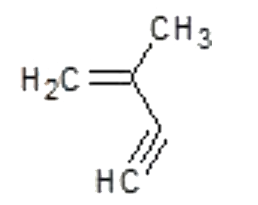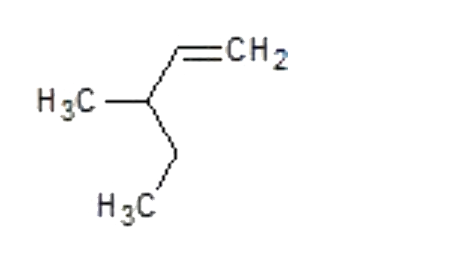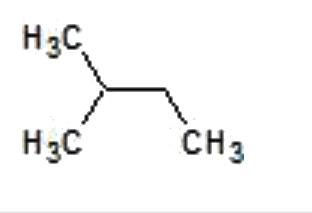An organic compound C4H6 on ozonolysis give HCHO,CO2,CH3CHO. Compound will be:
H2C=CH−CH=CH2
CH3−CH=C=CH2
CH3−C≡C−CH3

The correct Answer is:b
To solve the problem, we need to identify the organic compound with the molecular formula C4H6 that, upon ozonolysis, yields the products formaldehyde (HCHO), carbon dioxide (CO2), and acetaldehyde (CH3CHO).
1. Determine the Degree of Unsaturation:
- The formula for calculating the degree of unsaturation (DU) is:
DU=(2C+2+N−H−X)2
- For C4H6:
- C=4
- H=6
- N=0 (no nitrogen)
- X=0 (no halogens)
- Plugging in the values:
DU=(2×4+2−6)2=(8+2−6)2=42=2
- This indicates there are 2 degrees of unsaturation, which could be due to double bonds or rings.
Hint: Remember that each double bond or ring contributes 1 to the degree of unsaturation.
2. Analyze the Products of Ozonolysis:
- The products of ozonolysis are HCHO, CO2, and CH3CHO.
- This suggests that the original compound must contain a structure that can break down to yield these specific products.
3. Consider Possible Structures:
- The presence of formaldehyde (HCHO) and acetaldehyde (CH3CHO) indicates that the original compound likely contains a double bond that can be cleaved to form these aldehydes.
- The formation of carbon dioxide (CO2) suggests that one of the carbon atoms in the original compound is likely to be part of a carbonyl group that is oxidized to CO2.
4. Propose a Candidate Compound:
- A plausible structure for C4H6 that fits these criteria is 2-butyne (CH3C≡CCH3) or 1-butyne (CH≡CCH2CH3).
- Upon ozonolysis, 1-butyne would yield:
- CH3CHO (acetaldehyde)
- HCHO (formaldehyde)
- CO2 (from the terminal carbon).
5. Confirm the Reaction:
- When 1-butyne undergoes ozonolysis, the triple bond breaks, leading to the formation of:
- One molecule of acetaldehyde (CH3CHO)
- One molecule of formaldehyde (HCHO)
- One molecule of carbon dioxide (CO2) from the terminal carbon.
6. Final Answer:
- The compound that fits all the criteria is 1-butyne (C4H6).
Summary:
The organic compound C4H6 that gives HCHO, CO2, and CH3CHO upon ozonolysis is 1-butyne.
- The formula for calculating the degree of unsaturation (DU) is:
DU=(2C+2+N−H−X)2
- For C4H6:
- C=4
- H=6
- N=0 (no nitrogen)
- X=0 (no halogens)
- Plugging in the values:
DU=(2×4+2−6)2=(8+2−6)2=42=2
- This indicates there are 2 degrees of unsaturation, which could be due to double bonds or rings.
- The products of ozonolysis are HCHO, CO2, and CH3CHO.
- This suggests that the original compound must contain a structure that can break down to yield these specific products.
- The presence of formaldehyde (HCHO) and acetaldehyde (CH3CHO) indicates that the original compound likely contains a double bond that can be cleaved to form these aldehydes.
- The formation of carbon dioxide (CO2) suggests that one of the carbon atoms in the original compound is likely to be part of a carbonyl group that is oxidized to CO2.
- A plausible structure for C4H6 that fits these criteria is 2-butyne (CH3C≡CCH3) or 1-butyne (CH≡CCH2CH3).
- Upon ozonolysis, 1-butyne would yield:
- CH3CHO (acetaldehyde)
- HCHO (formaldehyde)
- CO2 (from the terminal carbon).
- When 1-butyne undergoes ozonolysis, the triple bond breaks, leading to the formation of:
- One molecule of acetaldehyde (CH3CHO)
- One molecule of formaldehyde (HCHO)
- One molecule of carbon dioxide (CO2) from the terminal carbon.
- The compound that fits all the criteria is 1-butyne (C4H6).
The organic compound C4H6 that gives HCHO, CO2, and CH3CHO upon ozonolysis is 1-butyne.
Topper's Solved these Questions
- HYDROCARBONS (ALKENES)BOOK - MS CHOUHANCHAPTER - HYDROCARBONS (ALKENES)EXERCISE - Level 1 (Q.1 To Q.30)
1 Videos
- HYDROCARBONS (ALKENES)BOOK - MS CHOUHANCHAPTER - HYDROCARBONS (ALKENES)EXERCISE - Level 1 (Q.61 To Q.90)
2 Videos
- HYDROCARBONS (ALKANES)BOOK - MS CHOUHANCHAPTER - HYDROCARBONS (ALKANES)EXERCISE - Level 1 (Q.31 To Q.50)
1 Videos
- HYDROCARBONS (ALKYNES)BOOK - MS CHOUHANCHAPTER - HYDROCARBONS (ALKYNES)EXERCISE - Level 1 (Q.1 To Q.30)
2 Videos
Similar Questions
An organic compound C4H6 on reductive ozonolysis gives HCHO,CO2 and CH3C=CH−CH=CH2 Find structure of compound.
View Solutioni) An organic compound, C4H6, on ozonolysis gives formaldehyde and glycol. What is this compound?
ii) C4H6 can represent various structures, Identify:
a) Which reacts with ammoniacal AgNO3,
b) Which does not react with ammoniacal AgNO3 but by hot aklkaline KMnO4 gives CH3COOH,
c) Which decolourises Br2 water and by catalyst hydrogenation (using 1 mol) and subsequent reaction with alkaline KMnO4 gives CH3COOH and
d) Which by ozonolysis using O3/H2O gives succinic acid.
View Solution
Knowledge Check
An organic compound (E)(C5H8), on hydrogenation gives a compound (F)(C5H12). Compound (E) on ozonolysis gives formaldehyde and 2−ketopropanal. Deduce the structure of the compouns (E).
A B
B C
C D
D
The olefin which on ozonolysis gives CH3CH2CHOandCH3CHO is-
A1-buteneB2-buteneC1-penteneD2-penteneThe olefin which on ozonolysis gives CH3CH2CHO and CH3CHO is
Abut-2-eneBpent−1−eneCpent-2-eneDbut-1-ene
An organic compound A(C6H10) on reduction first gives B(C6H12) and finally C(C6H14). Compound A on ozonolysis followed by hydrolysis gives two aldehydes D(C2H4O) and E(C2H2O2). Oxidation of B with acidified KMnO4 gives the acid F(C4H8O2). determine the structures of the compounds A to F with reasoning.
View SolutionAn organic compound (E)(C5H8), on hydrogenation gives a compound (F)(C5H12). Compound (E) on ozonolysis gives formaldehyde and 2−ketopropanal. Deduce the structure of the compouns (E).
View SolutionAn organic compound C6)H12(X) on reduction gives C6H14(Y). X on ozonolysis gives two aldehydes C2H4O(I)andC4H8O(II). Identify the compounds X, Y and aldehydes (I) and (II).
View SolutionAn organic compound (A) (C10H20) on reductive ozonolysis gives 2− methyl butanal. Based on this information, answer the following question.
1. Compound (A) is
View SolutionAn organic compound (A) and (C10H20) on reductie ozonolysis gives 2--methyl butanal. Based on this information, answer the following questions.
Compound (A) is :
View Solution
